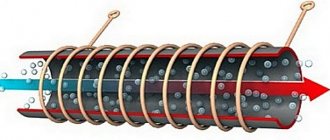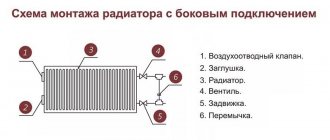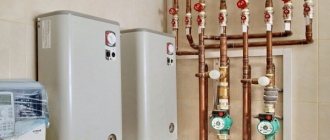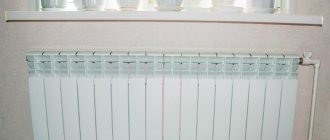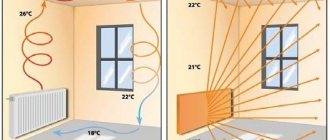The best heating radiators for a private home will be aluminum or steel products. They have high heat dissipation and an elegant design. The former can withstand a working pressure of 10-16 atm, the latter - 6-8 atm.
Installing radiators in a house is quite a difficult task. The purpose of the article is to help decide which heating devices are best installed in your home, to provide the most complete information about the best battery manufacturers, where and under what conditions it is rational to install and when this can be done.
The modern design of autonomous heating systems in private houses consists of water heating equipment (solid - liquid fuel, gas and electric boilers), hot water pipelines and heating devices (radiators).
It is important that the characteristics of the batteries fully correspond to the operating conditions.
Features of heating networks in a private house
Unlike multi-apartment buildings, an autonomous heating system is installed in a private house, that is, it does not depend on the central boiler room, which means that the pressure in the network and the temperature of the coolant will be completely different. Therefore, when choosing a radiator for a private home, you need to consider the following points:
- In private houses, the pressure on the coolant, and with it on the tanks and radiator pipes, is much less than in multi-storey buildings. Thus, the batteries do not experience overload, so you can choose any, including thin-walled models.
There is a horror story among residents of apartment buildings about pipes bursting due to water hammer due to sudden pressure surges in the water supply. In fact, there can be no water hammer even in apartment buildings, not to mention heating systems in cottages. But in private homes, especially those in which people do not live all the time, another problem may arise - freezing of water in the pipes. It is in this case that the batteries may simply burst if you forget to drain the water from the system before leaving.
Even cast iron batteries cannot always withstand system freezing Source ir-leasing.ru
- In a private house, the length of the pipeline from the heat source (boiler, stove) to the radiator is very short compared to multi-story buildings. Therefore, heat loss is minimal, and the coolant is more heated. Conclusion: in a private house there should be radiators that can withstand high-temperature coolant.
- A little liquid is needed to fill the heating system, so you can add antifreeze or ethyl alcohol to it. This protects pipes and radiators so that they do not freeze if the boiler is turned off for a long time.
Today, there is a large amount of antifreeze for radiators on the market.
One such option is Gibax antifreeze. When choosing, you must pay attention to the fact that antifreezes based on ethylene glycol and propylene glycol are prohibited from being used in systems that contain fittings, fittings, and pipes galvanized inside. At temperatures above 70 degrees, an intense chemical reaction occurs, which results in peeling of the galvanized layer, which leads to subsequent clogging of fittings, heating devices, etc. The second factor is the destruction of useful additives that protect the heating system from corrosion, as a result, the heating system begins to corrode intensively. For systems with galvanized products, glycerin-based antifreeze is used.
Adding antifreeze to the heating system Source homediz.info
- When choosing heating radiators, which ones are best for a private home should be determined based on the size of the heated area. In cottages there is a lot of space, and therefore energy consumption for heating is also large. It is advisable to install batteries that will warm up your home at a minimum cost.
Guided by these simple rules, you can buy the optimally suitable model.
Bimetallic
Bimetallic radiators are those that are made of aluminum and steel. But unscrupulous manufacturers even call bimetallic devices in which only the vertical channels of the collector are made of steel. This is incorrect, a real bimetallic radiator has a manifold made entirely of high strength carbon steel, in fact it is a steel manifold inside a section of aluminum. But in a private house, where the owners have the opportunity to monitor the quality of the coolant, this may not be so important, although the service life of bimetallic batteries is longer than that of aluminum ones. This can be considered an additional advantage, but bimetallic ones are also more expensive.
VseinstrumentiUser FORUMHOUSE
Bimetallic ones are stronger. I agree that it is usually more profitable to use aluminum radiators in a private home.
Classes of heating radiators and their types and features
The principle of operation of a radiator is to transfer heat to the surrounding space from the coolant fluid circulating in this heating device.
The autonomous heating system (AHS) consists of:
- boiler;
- pipelines;
- thermal elements.
Autonomous heating system Source gidroguru.com
The table shows the main types of heating devices:
| Device | Operating principle | Example |
| Radiator | Heat is radiated | ceiling radiant panels, sectional cast iron, tubular radiators |
| Battery | Heat is radiated and also transferred by convection | sectional aluminum, sectional steel, bimetallic, tubular |
| Convector | Heat is mainly transferred by convection | plate, tubular convectors, finned tubes |
In addition, heating devices are divided into the following classes; let’s consider a unique rating of heating radiators from this side:
Sectional
They consist of heating sections that are connected to each other. The more sections, the more heat they will transfer to the surrounding space. To prevent the room from overheating, special thermostats are installed on the radiators to regulate the temperature.
Thermostatic tap for temperature control Source drive2.ru
Standard cast iron radiators are also sectional: heat from them is transferred in the form of infrared radiation, evenly distributed throughout the room - top, bottom and middle. Such batteries have large dimensions and thick walls, which accumulate enough heat so that it is emitted in the infrared spectrum. It is this method of heating that is considered optimal for human health, although it must be borne in mind that part of the heating also occurs through convection.
Thanks to the thick walls, such batteries have high thermal inertia - therefore, after turning off the AOS, the radiators remain hot for a long time. Cast iron is not very susceptible to corrosion and is not afraid of harmful impurities in the coolant - the service life of such devices reaches 50 years. One of the disadvantages is the heavy weight.
Aluminum radiators have good heat transfer (1/2 radiation + 1/2 convection) and quickly warm up the room. Compared to cast iron, they are more lightweight, and in general, the ability to transfer heat into the room is several times higher than that of cast iron and steel.
Sectional radiator Source isu.org.ua
An additional advantage of modern models is the ability to regulate the temperature using a valve with a thermal head. The metal surface is coated with a protective coating, which increases its service life. The cost of aluminum radiators is low, and therefore the prices are more affordable.
Aluminum radiators cannot withstand high overloads, so they are not used in central heating systems (CHS). They break due to pressure surges, the presence of rust or sand particles in the coolant. Chemical additives are not allowed in liquids.
Bimetallic heating radiators consist of external aluminum plates and steel pipes located inside the sections. They are valued for their reliability and durability, but are not cheap. Equally well suited for centralized and autonomous heating systems.
which heating batteries are best for a private home Source nehomesdeaf.org
Radiators are also produced that have only steel-reinforced vertical pipes. These are no longer completely bimetallic devices; they are less corrosion resistant. Among their advantages, it is worth noting their high thermal conductivity, which is higher than that of real bimetallic radiators.
See also: Catalog of companies that specialize in home insulation
Tubular
Steel tubular heating devices give off heat well, are economical in terms of energy consumption, and heat up quickly. Their disadvantage is that they are sensitive to oxidative processes. If the coolant fluid does not fill the steel radiator reservoirs, it will begin to corrode. Another weakness of a steel radiator is its hypersensitivity to water quality. Even if the water is considered good by usual standards and can be drunk, it is recommended to install filters to minimize the formation of scale.
A steel tubular radiator can be placed in a narrow niche Source bouw.ru
The sizes of steel tubular radiators are from 30 cm to 3 m. The number of rows of tubes is 1–9. They are considered very reliable - the permissible operating pressure for devices from a number of Russian manufacturers reaches 15 atm. Radiator reservoirs are designed to hold a large volume of liquid, so they quickly reach the required temperature levels when it is necessary to increase or decrease power. The method of heat transfer is radiation and convection.
Steel radiators are also used as heated towel rails, which, in addition to drying clothes, provide additional heating in bathrooms
Steel tubular radiator-bench Source krovati-i-divany.ru
Floor radiators-benches with support legs are steel tubular heating devices with a seat in the form of a wooden board on top. They are connected to the heating system in the same way as conventional radiators. They can also serve as the main heating device in rooms such as the kitchen, bathroom, hallway.
Panel
These steel radiators are a rectangular panel that acts as a heating device. The panel consists of 2 ribbed sheets welded to each other; plates with a U-shaped relief are placed inside.
Steel panel radiator Source 999.md
Cast iron
Cast iron radiators are a classic, the most popular heating devices over the last hundred years. Long accordions of seven or eight sections can be seen in many retro photographs of Soviet apartments. Even then they were reliable, like a rock, withstanding any external mechanical impact and high pressure from the inside; they served for 50 years, got so hot that you couldn’t touch them, were resistant to corrosion and did not stop working even when they were “poorly heated” and the coolant temperature was low.
They are made from cast iron grade SCH 12-28, which is quite resistant to corrosion, using gaskets made of heat-resistant rubber - thanks to them, the products maintain tightness even when heated to 130 degrees.
But “cast iron” somehow looks antediluvian, they have a high heat capacity, many people talk about the sharp corners of the sections and the rough, unaesthetic casting surface. The best models of cast iron heating radiators are devoid of these shortcomings and will decorate any private home, some of them are even quite elegant, with smooth front surfaces and factory primer, with two- and three-column sections, which allows you to optimally reduce the width of the radiator for a given heat transfer.
TeploNetUser FORUMHOUSE
Cast iron radiators will never go out of style. Only the appearance will change.
A modern cast iron battery consists of several hollow sections, usually seven or eight, hermetically assembled together, with horizontal channels through which the coolant passes. Radiators can be one-, two- and three-channel. Their sizes are regulated by special GOST 8690-94 Cast iron heating radiators, according to which
- the distance between nipple holes should be from 300 to 800 mm;
- product height from 400 to 900 mm;
- depth from 100 to 160 mm.
Technical characteristics are given in the product labeling: this is how the MS-140-580-0.9-7 labeling is read: this is a product with a depth of 140 mm, a height of 580 mm, with a working pressure of 0.9 MPa, which consists of seven sections. This radiator fully complies with GOST.
The number of sections is simply calculated based on the area of the room (although there are also precise, complex and labor-intensive calculation methods that take into account many circumstances, from the region - winter is one thing in Moscow, and another in Irkutsk - to the number of windows in the room). A simple calculation is done like this: to heat a square meter of area, you need 100 W, therefore, by multiplying the area of the room by 100, we will find out how much heat is needed. Then we divide this value by the thermal power of one section of the selected model from the selected manufacturer.
The formula for calculating the number of sections of a cast iron battery is: multiply the area of the room by one hundred and divide by the thermal power of the section.
For a room of 21 square meters. meters according to this formula you will need 7.5 sections of a 160W radiator. It's better to round to eight than to seven.
There is nothing particularly difficult about installing cast iron batteries. Like all types of radiators, they must be installed at a certain distance from the wall, floor and window sill. These distances are regulated by SP 73.13330.2012 “SNiP 3.05.01-85. Internal sanitary systems of buildings."
- From the floor 60 mm;
- From the bottom surface of the window sill – 50 mm;
- 25 mm from the wall plaster surface (but the manufacturer may specify other dimensions).
RoaromaFORUMHOUSE user
The radiator will not operate at full capacity if the distance between it and the wall is not maintained. They passed, it’s not even discussed.
A cast-iron radiator is hung from the wall on metal supports, but sometimes, due to the design features of the house and the heavy weight of the device, it is placed on legs. Floor radiators are often stylized as antique ones, decorated with intricate castings; such products, even domestically produced, have a refreshingly high cost, but fit perfectly into a classic interior.
But when deciding on cast iron radiators, you should remember this important feature: they have high thermal inertia; They both heat up and cool down slowly. It will not be possible to quickly change the temperature in a room heated by cast iron radiators.
But in houses that are heated by solid fuel boilers, the disadvantages of cast iron become advantages: the large heat capacity in this case is rather a plus.
Lord LLC User FORUMHOUSE
Aluminum convectors quickly heat the air, but also quickly cool themselves. This is the reason for my choice of cast iron. If there was gas, I would install aluminum.
VashnovoselFORUMHOUSE user
Well, cast iron takes longer to heat up, well, inertia, so this is better with a solid fuel boiler and permanent residence!
And for houses connected to main gas, cast iron batteries, according to reviews from our users, are not the best choice.
TraksFORUMHOUSE User
My neighbor last year threw out cast iron and installed aluminum. Now pay less for gas. His house is well insulated; at a temperature of -25 degrees outside there is no need to heat the coolant to 90 degrees, 50-60 is enough.
Rules for the location of batteries in the house
In order for the system to work properly, installation rules must be strictly followed. Although the installation technology is not complicated, it has its own nuances, so the work must be carried out by specialists.
Important! If radiators are installed incorrectly, they are not covered by the warranty.
In order to avoid heat loss and uneven heating of the room, when installing devices it is necessary to observe indentations and choose the correct location:
- The most suitable option for the battery is considered to be a place under the window, i.e. where the heat loss is the most significant. The radiator width must be at least 70% of the window width. Mounted clearly in the middle.
Correct placement of the battery Source koffkindom.ru
- Leave at least 10 cm from the battery to the windowsill, as well as to the floor. The optimal distance between the floor and the radiator is 12 cm. It is not recommended to leave more than 15 cm.
- The battery is fixed at a distance of 5 cm from the wall.
- You can stick heat-reflecting material behind the radiator - then some of the heat will not go into the wall, but will return to the room.
- If the radiator is planned to be placed not under the window sill, but on the wall, then the distance between them should be at least 20 mm.
Selecting a specific radiator model
Once you have decided on the type and type of heating radiators you need, it’s time to calculate and select specific models of these radiators that will have the necessary technical parameters.
Calculating thermal power
How to choose the right heating radiators to achieve the proper level of warmth and comfort? To do this, you need to calculate the thermal power of the radiators you plan to purchase. For certain standard conditions, a thermal power of 0.09 to 0.125 kilowatts per square meter of room is required. This is exactly the power that should be enough to create optimal climatic conditions in the room.
Now about what is meant by standard conditions. Everything is simple, this is a room in which there is a window with a wooden frame and three-meter (no higher) ceilings, as well as an entrance door. At the same time, hot water at a temperature of seventy degrees flows through the heating pipes. If you have the same conditions, then multiplying 0.125 by the area of the room you will get the power of the radiator or radiators (if several are required) required for the room. Next, all that remains is to look at the passport of specific radiators and, having found out there the thermal power of one section or the entire radiator, select the required model.
But this is a simple calculation; in fact, it is necessary to take into account some other factors that will have an impact in this case:
- You can reduce the power of radiators by 10 - 20% if you have plastic energy-saving double-glazed windows installed in your room, because they reduce heat loss in the room by approximately that amount.
- If there are not one, but two windows in the room, then you need to place a radiator under each of them. Their combined capacity should be 70% higher than the standard value. We will do the same in the case of a corner room.
- When the hot water temperature increases or decreases for every 10 degrees, we also increase (or decrease) the power of the device by 15-18%. The thing is that if the temperature of the coolant decreases, then the power of the heating radiators decreases.
- If the ceilings are higher than three meters, the heating power must again be increased. The increase must be made as many times as the 3-meter ceilings in the room are higher. If the ceilings are lower, then you need to make a reduction.
When making calculations, we will take into account how our radiators will be connected. Here are some recommendations on this matter:
- If the coolant enters the radiator from the bottom and comes out from the top, then a fair amount of heat will be lost - from 7 to 10%.
- The lateral one-sided supply makes it unreasonable to install radiators longer than 10 sections. Otherwise, the last sections of the pipe will remain practically cold.
- Gluing a special reflective insulating material to the wall behind the radiator increases heat transfer by 10 to 15 percent. For example, it could be a material such as Penofol.
Of course, not all indicators are indicated here, for example, you need to take into account what material the house is built from, what its design is, whether there is insulation, but in general they allow you to choose the necessary heating devices.
Determine the required dimensions
When buying a radiator, you need to know exactly the following points:
- What type of eyeliner do you have - hidden or open?
- How are the pipes connected to the radiator, from the floor, from the wall, from above, from the side, etc.;
- Diameter of heating pipes;
- Distance between pipes (center distance).
We also provide for placing the radiator in such a way that air can flow freely around it - otherwise the room will not receive 10 to 15% of heat. The standards for placing radiators are as follows:
- The radiator distance from the floor is from 7 to 10 cm;
- distance from the wall – from 3 to 5 cm;
- distance from the window sill – from 10 to 15 cm.
Basic standards for the placement of radiators.
The final stage of purchasing radiators
Now, if you have autonomous heating, you can, taking these calculations with you, feel free to go to the store to buy heating appliances. But for residents of a high-rise building with a centralized heating system, it makes sense to first go to the emergency room after finding out what the operating pressure is in your heating system. We will build on this parameter when deciding which heating radiator is better to choose. The pressure indicated in the device passport must be higher than that indicated by the DEZ employees in order to obtain a certain reserve. After all, do not forget that in each new season, heating devices are tested with pressure testing, which is 1.5 times greater than the working one.
If you notice an error, a non-working video or link, please select a piece of text and press Ctrl+Enter .
0
Calculation of the number of sections
It is not necessary to look for the most expensive heating devices to make the room comfortable. The main thing is to correctly calculate the number of sections. If the rooms are standard, then this greatly simplifies the calculations.
Often they resort to calculations based on the volume of space because they are simple, but at the same time give fairly accurate results.
- 1 m³ requires 41 W of power. If good double-glazed windows are installed and heat loss is minimal, then the indicator drops to 34 W.
- Room volume (m³) = area (m²) × height (m).
- Required heating power for the entire room (W) = room volume (m³) × 41 W (or 34 W).
- In the technical data sheets of devices, manufacturers indicate the heat transfer of one section.
- The total power (the value calculated in point 3) must be divided by the heat transfer of one section. The resulting number is the number of sections.
For example, the required thermal power is 2890 W, and the heat output of one section is 170 W. Then for this room you need to purchase 17 sections.
In a non-standard room, calculations are made using a more complex formula Source rmnt.mirtesen.ru
If the room is non-standard, the calculations become more complicated. To calculate the total power, the features of double-glazed windows (double or triple), thermal insulation parameters of the walls, the ratio of the sizes of windows and floors, ceiling heights and other parameters are taken into account. Designers calculate all this using specialized software.
Radiant heating
Radiant heating
another type of electric. Radiant (IR) heating is based on the supply of heat to the heated room due to thermal radiation. Heating devices are most often located under the ceiling or even in the ceiling, while infrared radiation heats all objects located in its area of effect. The advantages of this type of heating include high efficiency, noiselessness and mobility, the ability to be useful even in cases where the room is open.
Which radiators to choose for a wooden house
Heating a wooden house (we are talking primarily about log houses) indeed has its own characteristics, since the thermal conductivity of wood is low and depends on its species. In addition, it is necessary to ensure maximum fire safety. But in general, the issue of providing heat, as well as safety, rests primarily on the correct installation of the heating system, the choice of boiler and the number of radiators. There are no restrictions on the type of radiators here: steel, cast iron, bimetallic, aluminum - all of them can be used in a wooden frame.
Any type of radiator is suitable for a wooden house Source pinterest.com
Electric heating
Electric heating is one of the easiest to install and maintain, the disadvantage is that it does not always have the necessary power and the high cost of electricity. It differs according to the type of heating devices.
Electric convectors heat the room due to the heating and distribution of air (convection) passing through the panel, without heating the front surface, which completely eliminates any possibility of burns or fire. They do not require expensive installation work during installation, maintenance during operation, and all this with the maximum level of comfort.
Simply install the electric convector in the chosen location and plug it into the outlet. The electronic temperature maintenance system allows you to combine electric convectors in separate rooms to heat the entire building.
Which heating batteries to choose for a private home and cottage
It is not difficult to select batteries for a private home, because the autonomous heating system operates without significant overloads, which a centralized system experiences. Here you can connect any radiators, focusing on the required power, quality, efficiency, and cost of the device.
Many owners of private houses prefer aluminum radiators. They are cheaper than cast iron, more economical to operate and have higher heat transfer rates, and the sensitivity of aluminum devices to water hammer in an autonomous heating system can be neglected.
If you want to choose batteries based on the brand name, then you can take into account the unspoken rating of aluminum heating radiators for a private home. The top positions here belong to the brands Calidor, Global, Rifar, STI, which are well suited for operation in Russian climatic conditions.
Modern radiators will provide a comfortable atmosphere in the room even in the coldest weather Source nehomesdeaf.org
Steel radiators are no less common, which is not surprising, because they are reliable, affordable, able to warm up quickly and have good heat dissipation. Here, in the ranking of steel heating radiators for a private home, the leading places are occupied by Kermi, Purmo, Zehnder, Sunerzha.
Among the worthy brands producing bimetallic radiators are the Russian Rifar and the Italian Global. Those who decide to purchase cast iron heaters should pay attention to Konner (Russia), Guratec (Germany), Retro Style (Russia).
As a result, all radiators are universal, which means posing the question of which heating radiators are best for a private house with a gas boiler is not entirely correct, because when choosing, they are mainly guided by the required power, the features of the room and the possibilities of the budget.
How to decide on the type of radiator
Now it’s probably easier for you to decide which radiator to choose for your apartment - after all, out of the four options considered, there are only two left. As it turned out, neither steel nor aluminum radiators will withstand the test of either aggressive domestic coolant or pressure drops. So, what remains are bimetallic and cast iron appliances. What exactly to buy, look at your budget, as well as the characteristics of specific models. However, here you can give a couple of tips.
- In old houses (for example, “Khrushchev” buildings) it is quite possible to install cast iron products. If you live in a high-rise building, where the pressure of the heating system is higher, then it is still better to take bimetallic radiators.
- If the predecessors of your future new batteries are made of cast iron, then you can choose either of two options. Both bimetal and cast iron are suitable. If you are going to replace batteries made of another metal, then change them only to bimetallic ones.
Radiator prices
The cost of heating devices varies significantly depending on the following factors:
- brand and country of origin;
- material and production technology;
- design.
Italian, German, Finnish, and Czech batteries are more expensive than Russian ones, but in terms of their technical and operational characteristics, products from domestic manufacturers are not much inferior and even superior to many foreign analogues.
Buying heating radiators for a private home is quite expensive. But if you make the right calculations and select cost-effective devices, then costs can be significantly reduced.
The average cost of aluminum radiators per section is in the range of 1227–8200 rubles, bimetallic devices – 3000–11900 rubles. The cheapest of them can be purchased at a price of 1100 rubles. The range of prices for steel radiators is also quite wide: from 830 to 60,000 rubles. Steel models costing from 3,500 to 26,000 rubles are popular. Inexpensive cast iron batteries can be purchased for 500–1000 rubles. Cast iron appliances are in demand for RUR 3,000–8,000.
Retro-style batteries can be found from 8,000 rubles.
Cast iron batteries in retro style Source gidroguru.com
If batteries are needed for an entire house, then even inexpensive devices cost a pretty penny. In addition, costs will be added for related products: valves, thermostat heads, brackets and other parts.
Trusted manufacturers
On the Russian heating engineering market there is a wide range of heating radiators, the manufacturers of which are known for their quality products.
The best radiators are presented by several well-known manufacturers.
Aluminum
Among products of this type, two manufacturers worth noting are Global ISEO and Royal Thermo Revolution.
DO NOT BUY Radiators Until You See THIS!!!
Global ISEO
The Italian company Global ISEO has been manufacturing aluminum radiators for more than fifty years. Elegant products fit harmoniously into window sill niches and look great in the open. The model range is represented by devices with different numbers of sections. The average price of a radiator of 8 sections is 5.2 thousand rubles, of 10 sections – 10.2 thousand rubles.
Royal Thermo Revolution
This brand has established itself as a manufacturer of reliable products at an affordable price. Impeccable design, increased power, resistance to water hammer and a 10-year warranty - all this indicates the high quality of aluminum batteries. The average price of a Royal Thermo Revolution radiator with 10 sections is 10.8 thousand rubles.
Steel
The best steel radiators are represented by manufacturers such as Kermi and Buderus.
Radiator in the heating system of a private house.
Kermi
The Kermi brand presents one of its best steel batteries, the Kermi FKO 22 with side connection. German products are made from high-quality low-carbon steel. Thanks to this, radiators are characterized by high performance.
All devices are supplied with a complete set of brackets, plugs and an air valve. The average price of a 500 x 800 mm panel is 6.3 thousand rubles.
Buderus
The German company is one of the manufacturers of high-quality products such as steel panel heating radiators. One of the best models, Buderus Logatrend VK-Profil 22, is made by roller welding.
The devices have an elegant appearance and are designed for 50 years of trouble-free service. The average price of this model measuring 500 x 600 mm is about 5 thousand rubles.
Cast iron: MS-140 and GURATEC Apollo 970/05
The budget version of cast iron products is presented by the Lugansk Foundry and Mechanical Plant. They are preferred to be installed in public places and non-residential premises. The cost of one battery from section 5 of MS-140 with a height of 800 mm is on average 2.7 thousand rubles.
The German company Guratec is considered one of the best foreign manufacturers of cast iron batteries. The products are made in retro style. The products are expensive because each device is a unique work of art with painting and monograms in a wide color range. A cast iron radiator GURATEC Apollo 970/05 will cost the buyer about 90 thousand rubles.
Bimetal: SIRA GLADIATOR 500x4 and ROYAL Thermo Revolution Bimetall 350
In the heating engineering market, the Italian company Sira Group is known for its high-quality Gladiator bimetallic radiators. The wide range of products includes models Alfa Bimetal, Gladiator, RS Bimetal, etc. The average price of a bimetallic radiator model SIRA GLADIATOR 500x4 is about 3.6 thousand rubles.
Bimetallic devices ROYAL Thermo Revolution Bimetall 350 are of high quality. The main advantage is a seven-layer anti-corrosion coating, which allows the batteries to be used in rooms with high humidity levels (gyms, swimming pools, etc.). The average cost of a 60 x 415 mm radiator is 8.3 thousand rubles.
Vacuum: EnergyEco
The Russian company EnergyEco is considered one of the best manufacturers of vacuum heating radiators. The devices are made of 1.5 mm steel. The heat output of 1 section is 170 kW. The average price of a lithium bromide flow radiator of 10 sections is 7 thousand rubles.
Quartz: TeplEco
Judging by the 2021 ratings, the Russian company TeplEko was named the best manufacturer. Quartz panels can be installed in rooms with high humidity. For a bathroom, a 400W stove will provide a comfortable air temperature. A quartz monolithic slab measuring 600 x 350 x 25 mm costs an average of 2.6 rubles.
Let's compare the models
| Model | Material | Heat dissipation, W | Max. temperature, °C | Volume, l | price, rub. |
| Rifar Base 500 | bimetallic | 1224 | 135 | 1.2 | 4200 |
| Royal Thermo BiLiner 500 | bimetallic | 666 | 110 | 1.23 | 4740 |
| Global STYLE PLUS 500 | bimetallic | 684 | 110 | 1.14 | 5340 |
| Sira RS Bimetal 500 | bimetallic | 1206 | 110 | 1.19 | 5100 |
| Royal Thermo Revolution 500 | aluminum | 666.9 | 110 | 2.22 | 3590 |
| Rifar Alum 500 | aluminum | 1098 | 135 | 1.62 | 3600 |
| ROMMER Al Optima 500 | aluminum | — | 110 | 1.68 | 2150 |
| Global ISEO 500 | aluminum | 690 | 110 | 2.64 | 3900 |
| Arbonia 2180 1800 | steel | 780 | 120 | 9.36 | 12400 |
| Axis Classic 22,500 | steel | — | 120 | — | 2790 |
| Kermi FKO 22 500 | steel | 1808 | 110 | 5.4 | 6670 |
| Buderus Logatrend K-Profil 22 500 | steel | 1826 | 120 | 6.3 | 4670 |
| STI Nova 500 | cast iron | 720 | 150 | 3.12 | 3840 |
| RETROstyle DERBY M 200 | cast iron | 137 | 110 | — | 2920 |
| Viadrus Styl 500/130 | cast iron | 70…1400 | 115 | 0.8…16 | 3100 |
| Iron Lion Azalia 660 | cast iron | — | 110 | — | 4600 |
back to menu ↑




